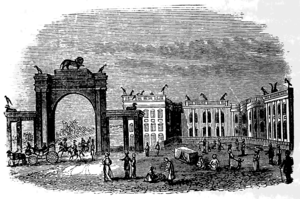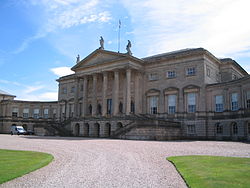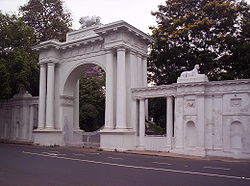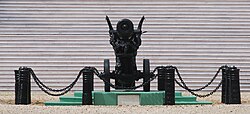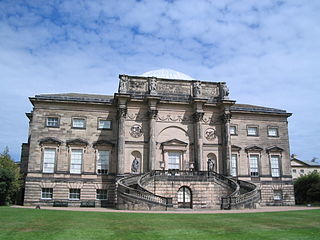
Kedleston Hall is a neo-classical manor house owned by the National Trust, and seat of the Curzon family, located in Kedleston, Derbyshire, approximately 4 miles (6 km) north-west of Derby. The medieval village of Kedleston was moved in 1759 by Nathaniel Curzon to make way for the manor. All that remains of the original village is the 12th century All Saints Church, Kedleston.

The Governor-General of India was the representative of the monarch of the United Kingdom in their capacity as the Emperor/Empress of India and after Indian independence in 1947, the representative of the Monarch of India. The office was created in 1773, with the title of Governor-General of the Presidency of Fort William. The officer had direct control only over his presidency but supervised other East India Company officials in India. Complete authority over all of British territory in the Indian subcontinent was granted in 1833, and the official came to be known as the "Governor-General of India".

The Rashtrapati Bhavan is the official residence of the President of India at the western end of Rajpath, Raisina Hill, New Delhi, India. It was formerly known as Viceroy's House and constructed during the zenith of British Empire. Rashtrapati Bhavan may refer to only the 340-room main building that has the president's official residence, including reception halls, guest rooms and offices, also called the mansion; it may also refer to the entire 130-hectare (320-acre) Presidential Estate that additionally includes the presidential gardens, large open spaces, residences of bodyguards and staff, stables, other offices and utilities within its perimeter walls. In terms of area, it is the second largest residence of any head of state in the world after Quirinal Palace in Italy. The other presidential homes are the Rashtrapati Nilayam in Hyderabad, Telangana and The Retreat Building in Shimla, Himachal Pradesh.

Presidency University, Kolkata is a public state university located in College Street, Kolkata. It was among the best colleges in the country when the institute was affiliated to University of Calcutta. The institution was elevated to university status in 2010 after functioning as a constituent college of the University of Calcutta for about 193 years. Currently, it continues to rank among the top universities in India.

The Delhi Durbar was an Indian imperial-style mass assembly organized by the British at Coronation Park, Delhi, India, to mark the succession of an Emperor or Empress of India. Also known as the Imperial Durbar, it was held three times, in 1877, 1903, and 1911, at the height of the British Empire. The 1911 Durbar was the only one that a sovereign, George V, attended. The term was derived from the common Persian term durbar.

The Belvedere Estate consists of Belvedere House and the 30-acre (12 ha) grounds surrounding it. It is located in Alipore, near the zoo, in Kolkata. In 1858, after the Governor-General moved out, the Lieutenant-Governor of Bengal took up residence in Belvedere House. When the capital moved from Kolkata to Delhi in 1911, the Lieutenant-Governor of Bengal, who had hitherto resided in Belvedere House, was upgraded to a full governor and transferred to Government House. Belvedere House has been the home of the National Library of India since 1948.
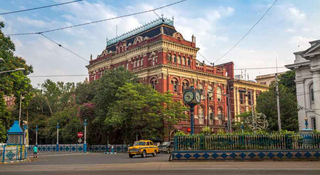
Binoy-Badal-Dinesh Bagh, shortened as B. B. D. Bagh, formerly called Tank Square and then Dalhousie Square, is the administrative, financial and commercial region and one of the central business districts of Kolkata, capital of the Indian state of West Bengal. It is the seat of Government of West Bengal and houses all three branches of it. The area consists Writers' Building, the official state secretariat building, Raj Bhavan, the residence of Governor of West Bengal, Vidhansabha Bhavan, the building housing the West Bengal Legislative Assembly and also the Calcutta High Court.

The Raj Bhavan at Darjeeling is the summer residence for the Governor of West Bengal. It is located in the city of Darjeeling, West Bengal.

The Bangabhaban is the official residence and principal workplace of the president of Bangladesh, located on Bangabhaban Road, and short road connecting Dilkusha Avenue, Dhaka. It is surrounded by the Bangabhaban Gardens.
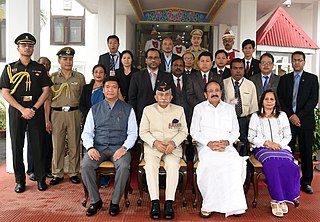
Raj Bhavan is the official residence of the governor of Arunachal Pradesh. It is located in the capital city of Itanagar, Arunachal Pradesh. The present governor of Arunachal Pradesh is Kaiwalya Trivikram Parnaik.
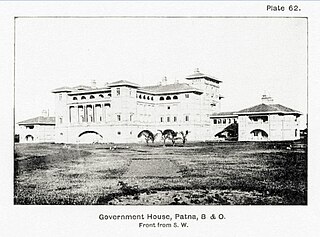
Raj Bhavan is the official residence of the governor of the Indian state of Bihar. It is located in the state capital of Patna. Construction started in 1912 and was completed in 1917. It was designed by New Zealand-born architect Joseph Fearis Munnings.
Raj Bhavan is the official residence of the governor of Kerala. It is located in the capital city of Thiruvananthapuram, Kerala. Built in 1829 as Palace Guest house of Travancore Government Guest, this heritage structure hosts the present governor of Kerala, Arif Muhammad Khan.
Charles Wyatt was an English architect and Member of Parliament for Sudbury, Suffolk.

The Victoria Memorial is a large marble monument dedicated to Queen Victoria, the Empress of India (1876-1901) facing the Queens Way on the Maidan in Central Kolkata. It was built between 1906 and 1921 by the British Raj.

Netaji Bhawan or Netaji Bhavan is a heritage building in Kolkata, West Bengal, maintained as a memorial and research center to the life of the Indian nationalist "Netaji" Subhas Chandra Bose. It is currently the headquarters of Netaji Research Bureau.
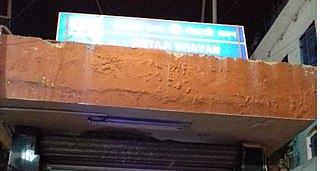
Netaji Bhavan is an underground metro station on the North-South corridor of the Blue Line of Kolkata Metro in Bhawanipore, Kolkata, West Bengal, India.

The Currency Building is an early 19th-century building in the B. B. D. Bagh central business district of Kolkata in West Bengal, India. The building was originally built in 1833 to house the Calcutta branch of the Agra Bank. In 1868, it was converted for use by the Office of the Issue and Exchange of Government Currency, an office of the Controller of the Currency under the British Raj. From 1935 until 1937, the Reserve Bank of India (RBI) used the building as its first central office. The building remained in use, and was used at one time by the Central Public Works Department (CPWD) as a storehouse. Authorities decided to demolish it in 1994.

The Esplanade Mansions is a heritage building located in the Indian city of Kolkata, on the Esplanade Row and Marx Engels Beethi Road crossing, opposite to the Raj Bhavan. It was one of the buildings owned by Jewish businessman David Elias Ezra. The residential building was built in the Art Nouveau architecture style. Today it is owned by Life Insurance Corporation and houses commercial, railways and other government offices.


